
Section F Roman, Muslim, and Crusader Periods
Chapter 66 - Dome of the Rock (Muslim)
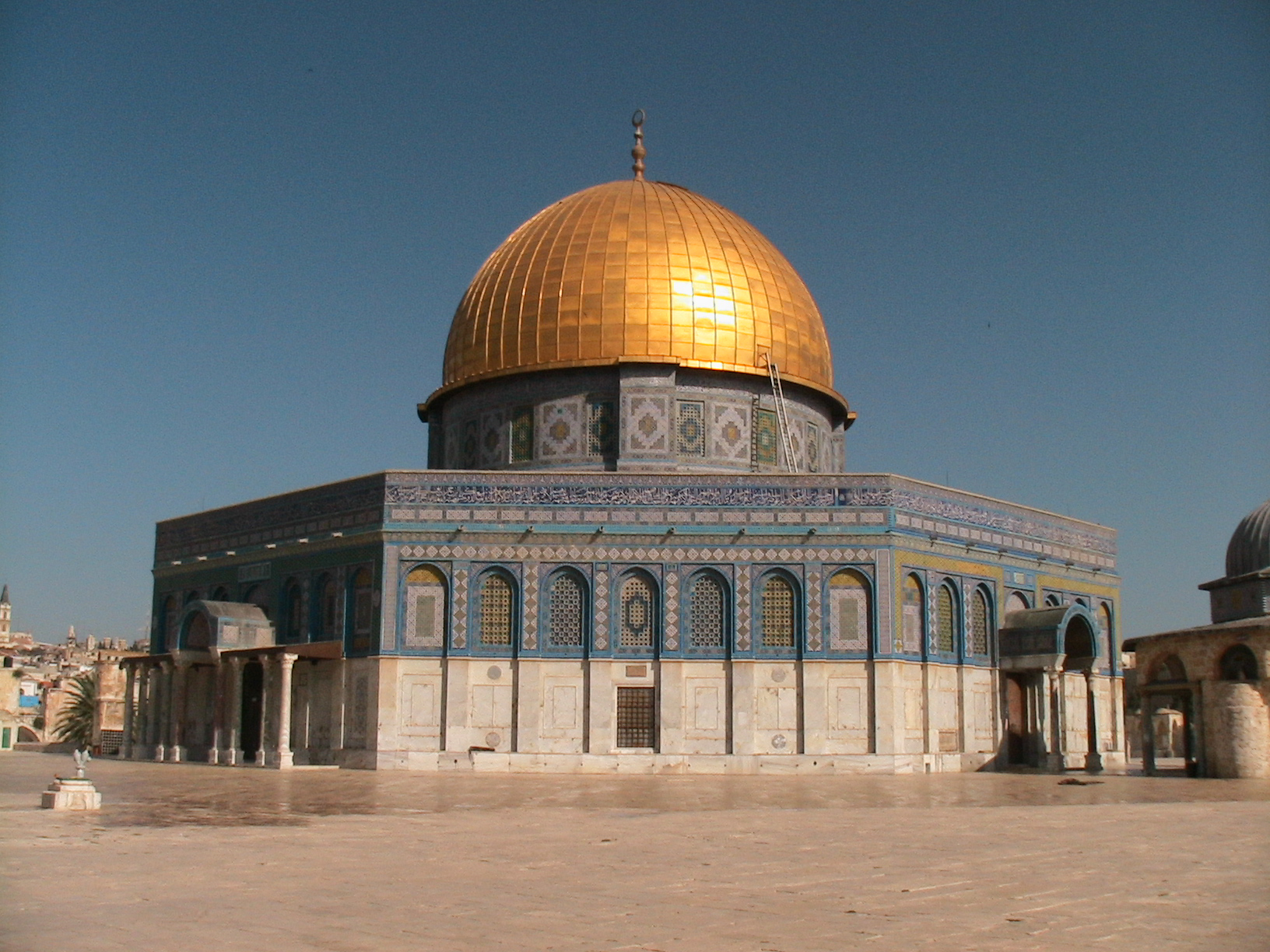
The Dome of the Rock is also called Qubbat Al-Sakhra. Caliph ‘Abd al-Malik began construction on this building in 688 and finished it in 691 AD. 1300 years of tradition and recent archaeological evidence strongly suggests that the Dome of the Rock sets on the site of the destroyed Jewish Temple and Most Holy Place. This is the oldest existing Islamic building in the world. It is an imitation of a Byzantine martyrium, which was an octagonal-shaped structure for honoring or preserving the relics of saints/martyrs. On the right side of the photo, about half of the Dome of the Chain is also visible. This would be in the general area of the Altar of Burnt Offerings. (In this photo, east is toward the right.)
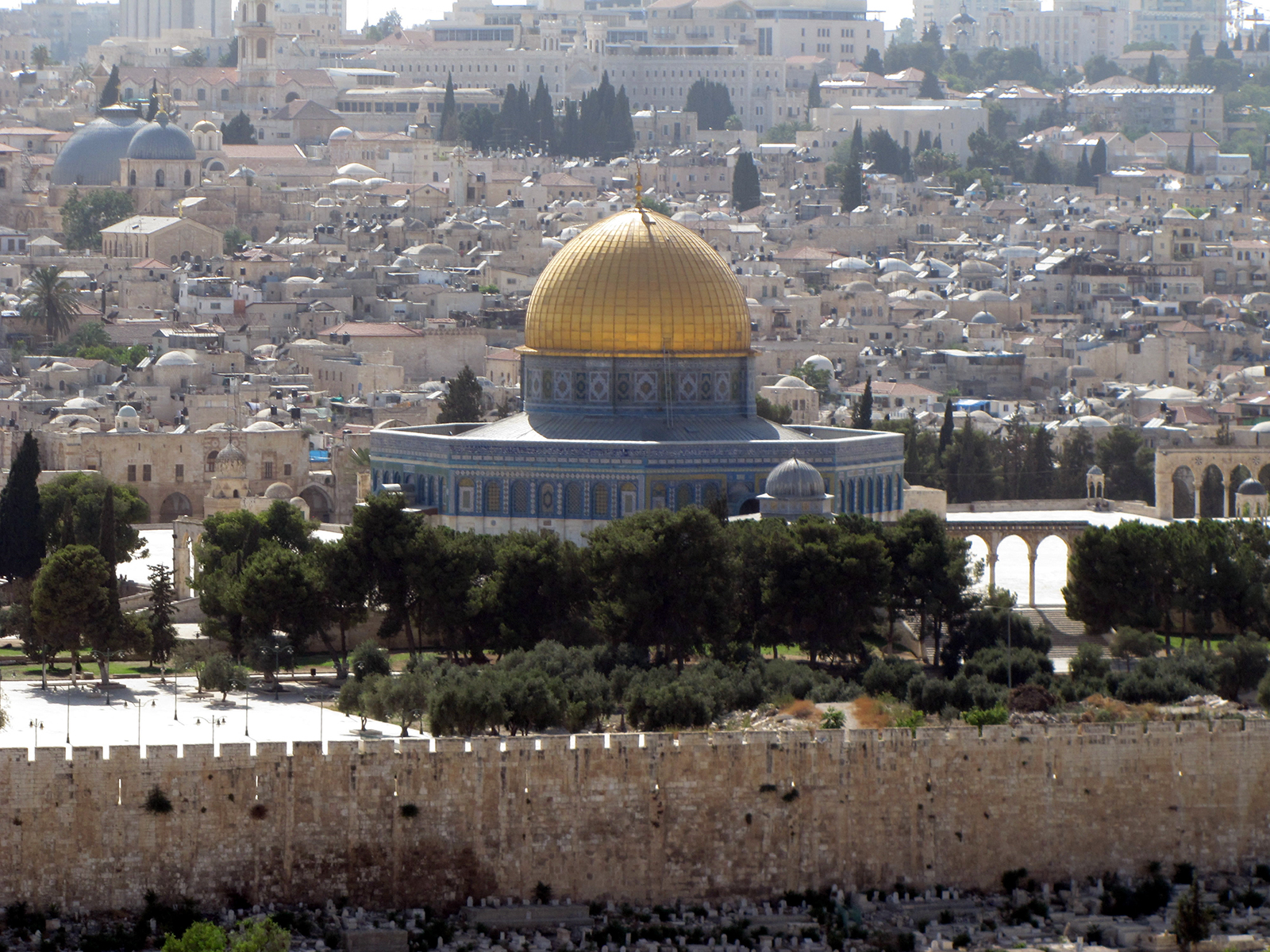
With the Dome of the Rock in the center, the two grey domes of the Church of the Holy Sepulcher can be seen slightly to the left of the Dome of the Rock in the Jerusalem skyline (in the upper right quadrant of this photo).
The construction of the Dome of the Rock was completed 1300 years ago in 691 by Caliph ‘Abd al- Malik. It was designed to be a visual rival of the Church of the Holy Sepulcher, which was the religious focus of the city when the Arabs conquered Jerusalem in 638. The golden dome is 66 feet in diameter.
When the Muslims took the city of Jerusalem in 638 they realized the importance and impressiveness the Church of the Holy Sepulcher had inside the city. The Church had become the center of the city.
The Arab historian Muqaddasi wrote in 985: “is it not evident that ‘Abd al-Malik, seeing the greatness of the martyrium of the Holy Sepulcher and its magnificence was moved lest it should dazzle the minds of the Muslims and hence erected above the Rock the dome which is now seen there?”
The grey domes of the Church of the Holy Sepulcher were copied by the builders of the Dome of the Rock, but were then covered in a golden color to show visitors the superiority of Islam.
The Dome was built over the site of the Jewish temple for the same reason. In fact, from the day the Dome of the Rock was built, it has been seen by Muslims as a replacement of the Jewish Temple on the very site of the temples built by Solomon, Zerubbabel and Herod.
The octagonal structure of the Dome of the Rock also mimics the shape that early Christians used to encircle and enshrine important holy sites. The remains of an ancient octagonal church built over the house of Peter in Capernaum are an example of this.
Inside the Dome of the Rock is an inscription in Arabic script from 691-692 that runs almost 800 feet in a narrow path around the octagonal walls as a form of Islamic artwork. This inscription reads: “O you People of the Book, overstep not bounds in your religion, and of God speak only the truth. The Messiah, Jesus, son of Mary, is only an apostle of God, and his Word which he conveyed unto Mary, and a Spirit proceeding from him. Believe therefore in God and his apostles, and say not Three. It will be better for you. God is only one God. Far be it from his glory that he should have a son.”
Some say it was from this rock that Muhammad ascended to heaven on a horse with the angel Gabriel. But, this is a 12th century tradition developed from a dream that involved Muhammad’s night journey, as described in the Koran in Sura 17:1:
Most glorified is the One who summoned His servant (Muhammad) during the night, from the Sacred Masjid (of Mecca) to the farthest place of prostration, whose surroundings we have blessed, in order to show him some of our signs. He is the Hearer, the Seer.
But, Jerusalem is not mentioned in this passage, nor is Jerusalem ever mentioned anywhere in the Koran. The Dome of the Rock was built 200 years before this tradition began to be told, so although this is the reason given for where it was built, that cannot be right.
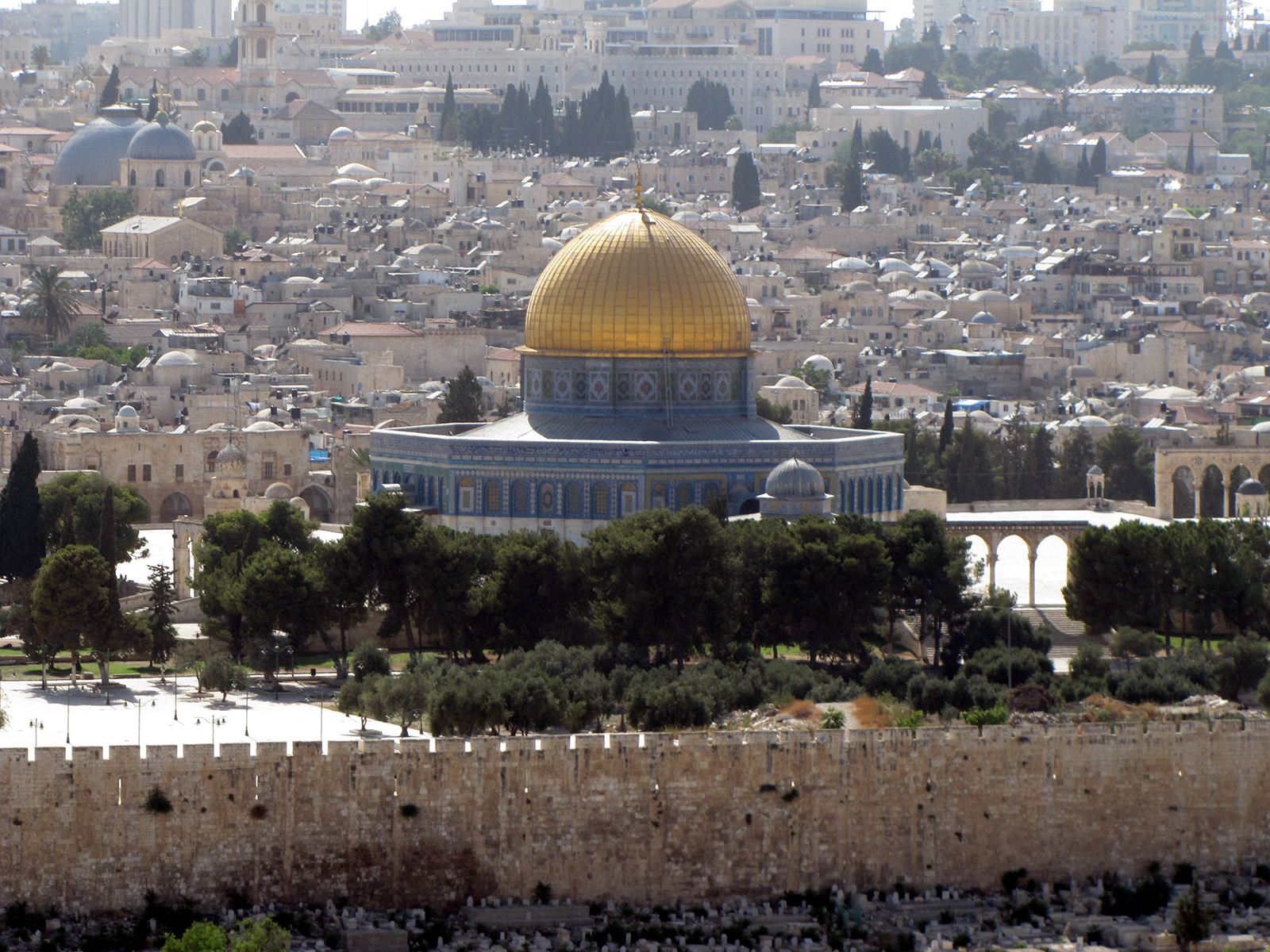
Looking southeast at the Dome of the Rock. The dome on the far right is the Dome of Ascension where early Muslim tradition says Muhammad ascended into heaven. Today the Muslim claim has changed to say he ascended from the rock under the Dome of the Rock. The dome on the left of the photo is the Dome of the Chain, which is where the Altar of Burnt Offering was located, in front of the Jewish Temple. The other smaller domes and small rock structures are wells leading down to some of the many cisterns under the Temple Mount.
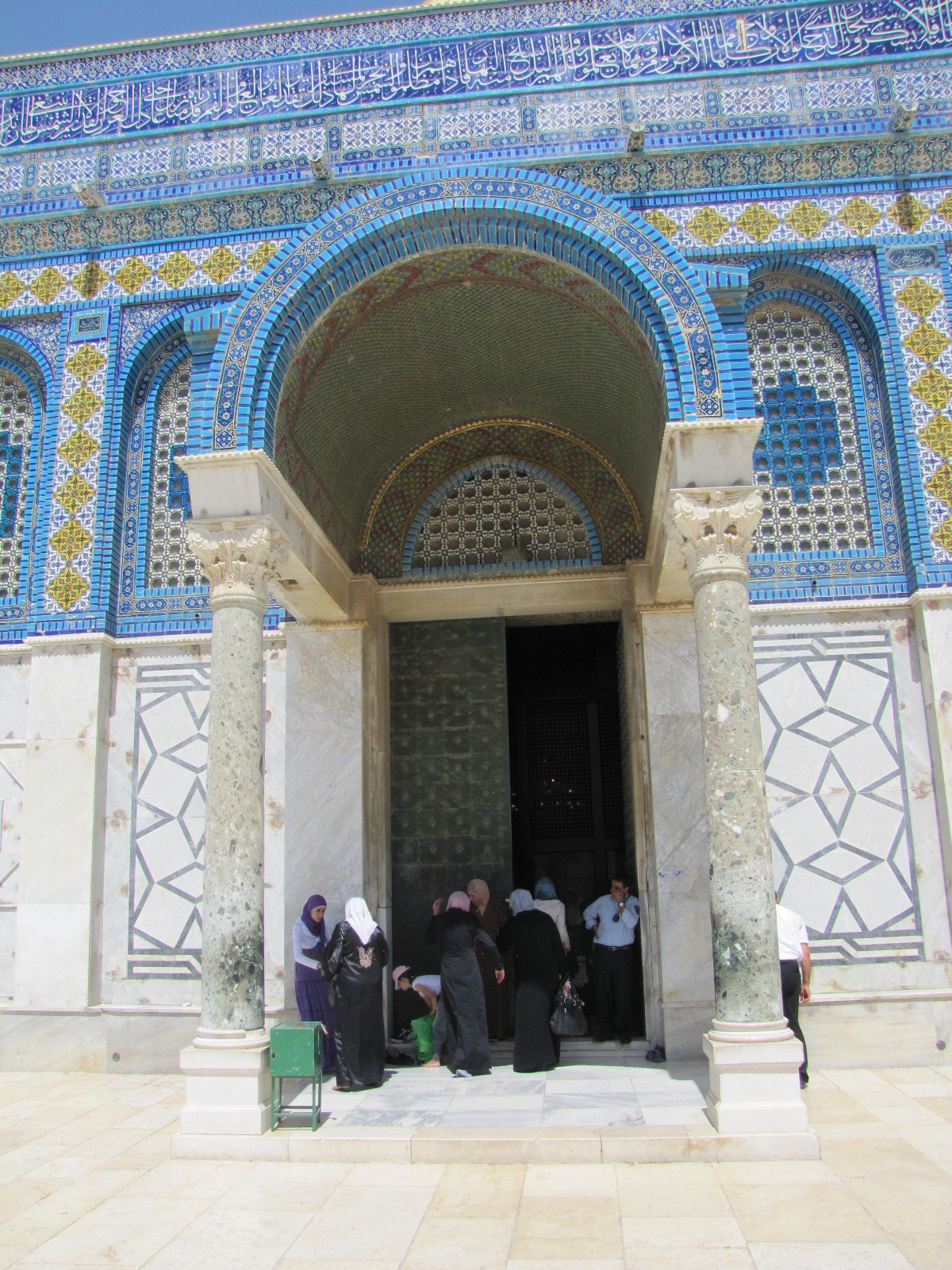
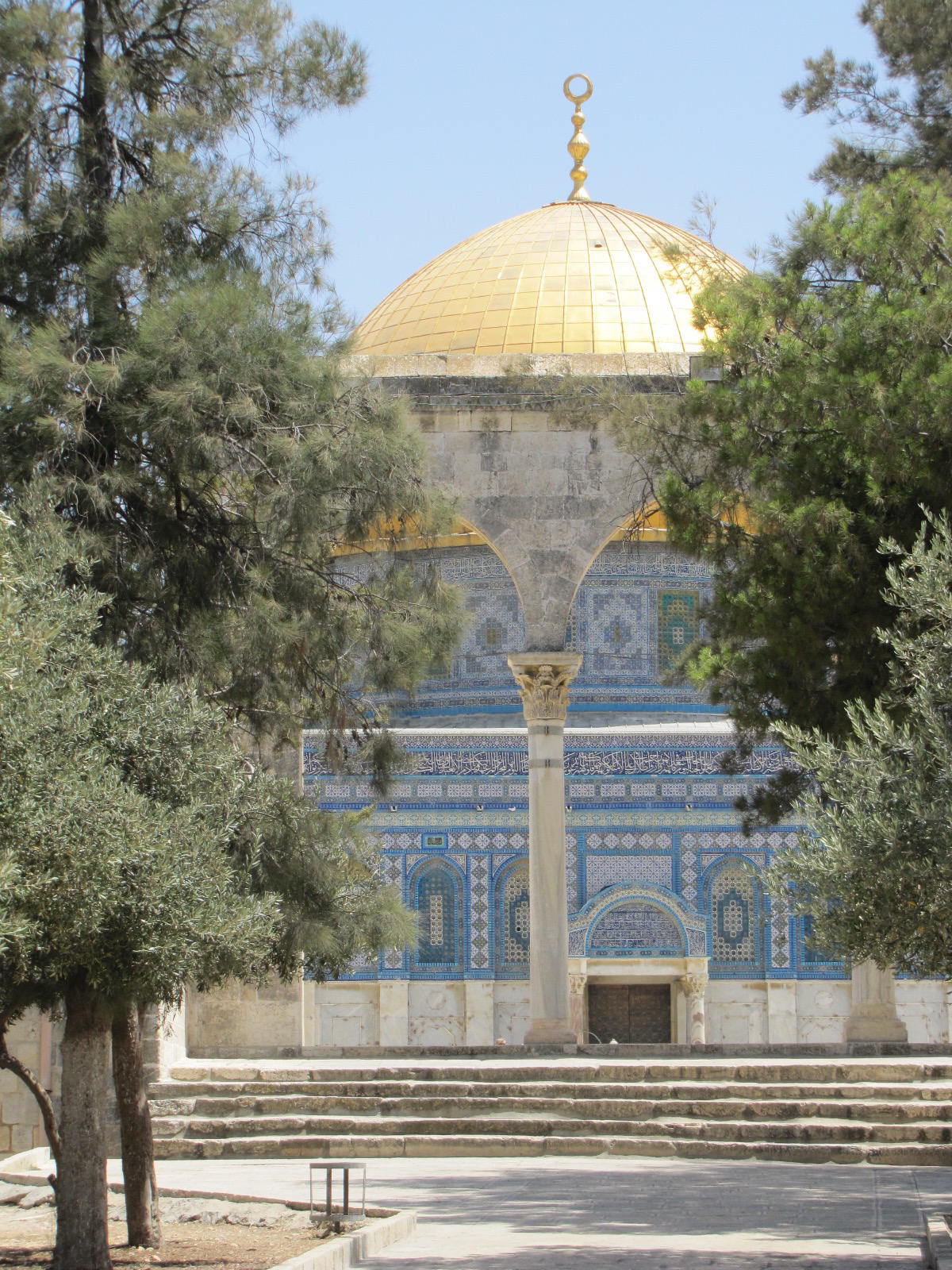
With the Dome of the Rock in the center, the two grey domes of the Church of the Holy Sepulcher can be seen slightly to the left of the Dome of the Rock in the Jerusalem skyline (in the upper right quadrant of this photo).
The Dome of the Rock is octagonal and covered with black, red and cream colored marble inlays. Glazed tiles of royal blue, white, yellow and green cover the upper portion of the walls. There are long quotes from the Koran written all around the outside of the building.
The inside glimmers with polished marble, stained glass windows, golden mosaics and woodwork. Two series of arches supported by columns, called arcades, enclose the rock mass that is the top of the original Mount Moriah in the center of the building.
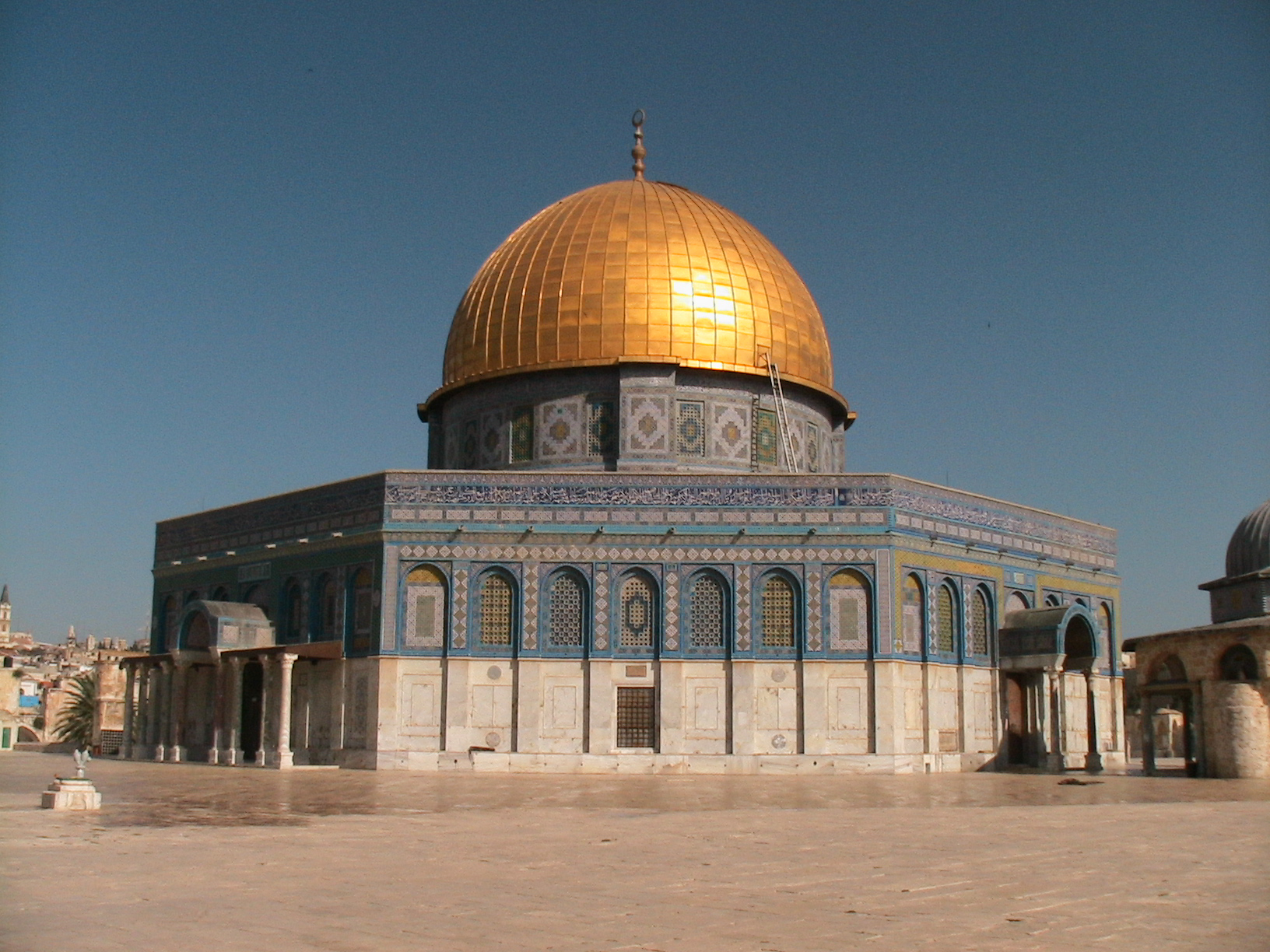
Detail of the tile and Arabic script on the outside surface of the Dome of the Rock.
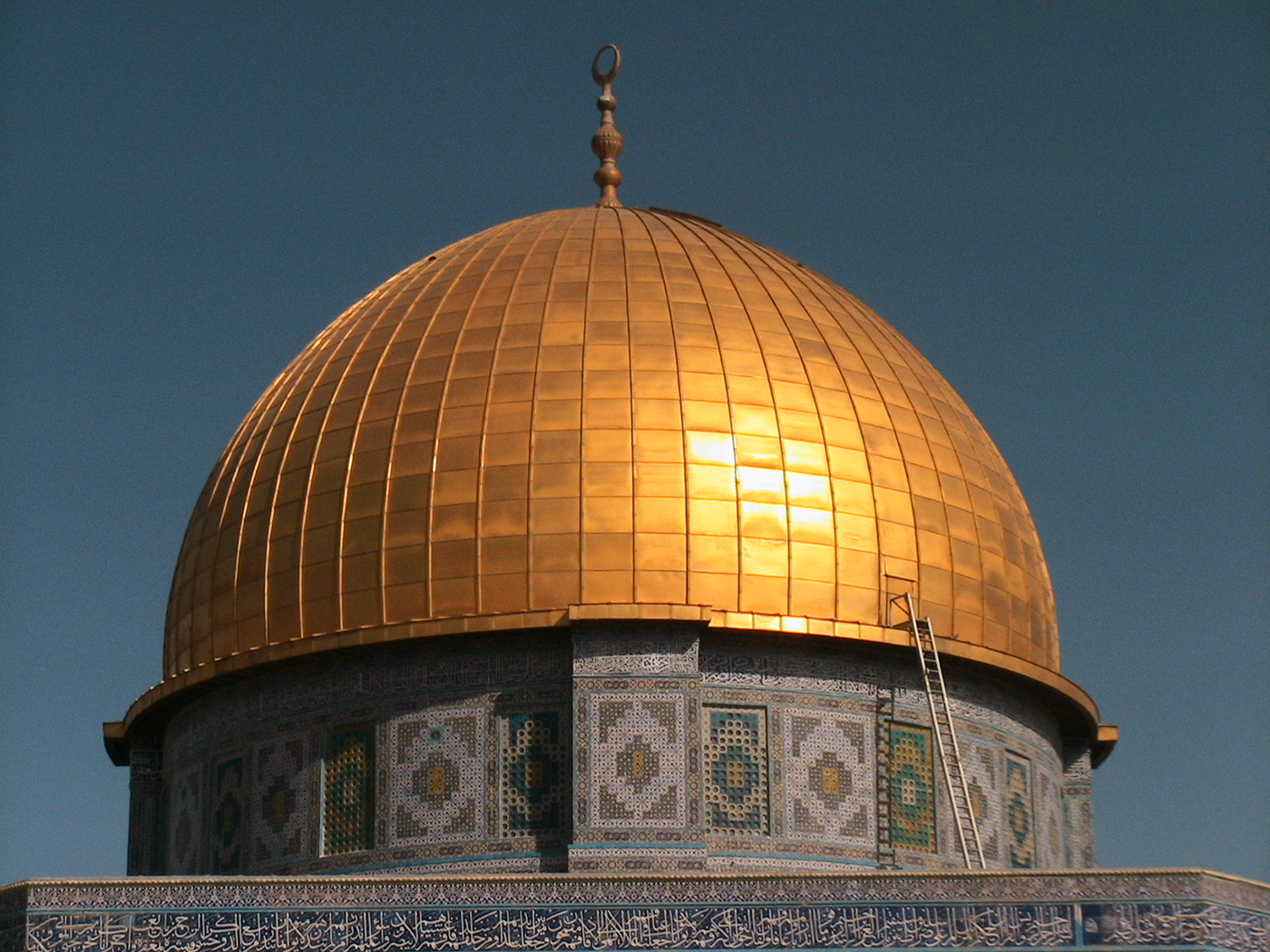
The dome on the Dome of the Rock was covered with an aluminum and bronze alloy in 1960. In 1998 it was covered with 176 pounds of gold (the value in 2010 dollars was $3,043,087) that was donated by King Hussein of Jordan. The diameter of this dome is 66 feet compared to the 69.5 foot width of the dome on the Church of the Holy Sepulcher, which the builders attempted to imitate. This dome is 67 feet high, and the dome of the Holy Sepulcher rises 69 feet.
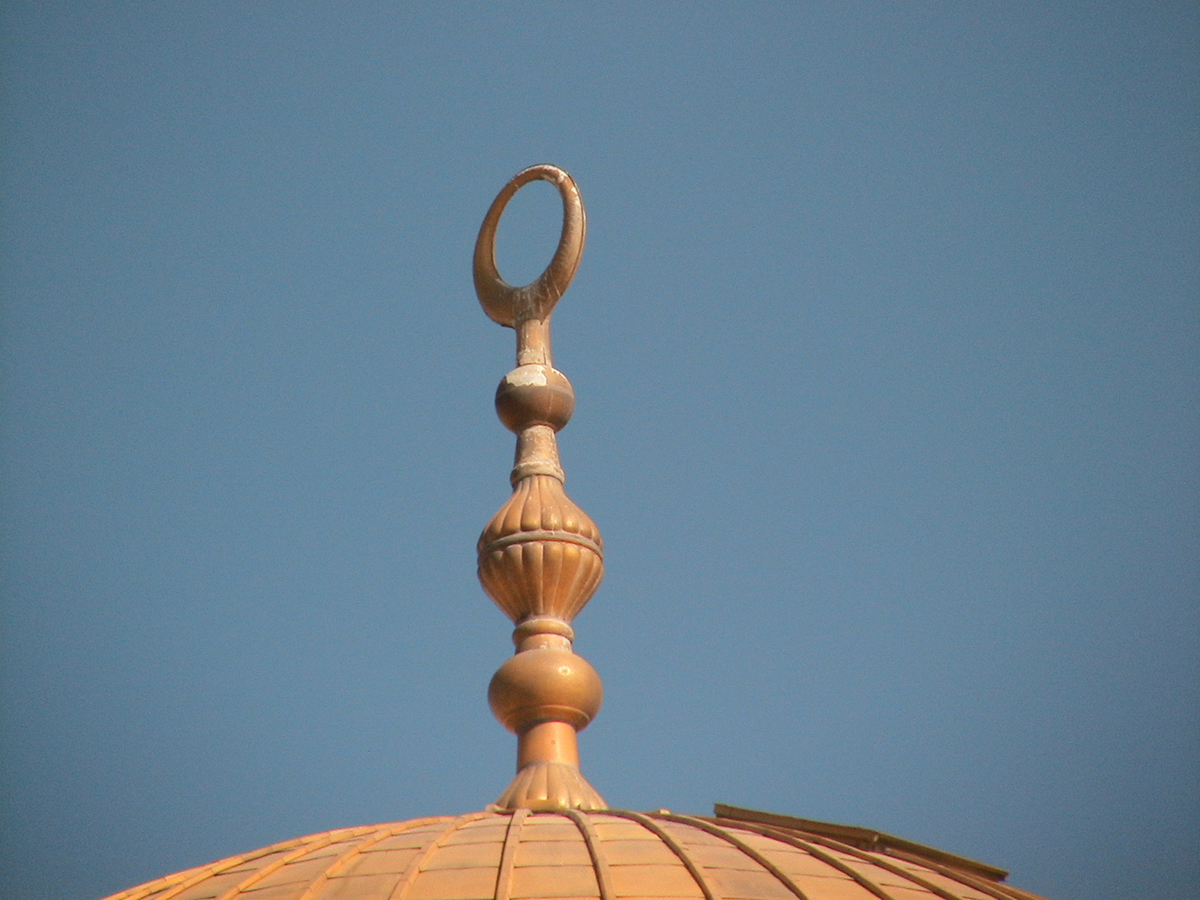
A crescent moon whose tips touch, creating a full moon, sets atop the dome of the Dome of the Rock. The moon is a traditional symbol of the moon-gods throughout the ancient Middle East throughout history. The Sumerians worshipped the moon-god named Sin whose symbol was the crescent moon. The temple of Sin has been excavated in Abraham’s old city of
Ur. YHWH told Abraham to leave his culture, his land and his family who were worshippers of this pagan moon-god (Genesis 12:1; Joshua 24:2). Throughout the Old Testament worship of the moon-god and other heavenly hosts is forbidden and met with judgment:
When you look up to the sky and see the sun, the moon and the stars – all the heavenly array – do not be enticed into bowing down to them and worshiping things the Lord your God has apportioned to all the nations under heaven.- Deuteronomy 4:19
In both courts of the temple of the Lord, Manasseh built altars to all the starry hosts. He sacrificed his own son in the fire, practiced sorcery and divination and consulted mediums and spiritists.- 2 Kings 21:5
Josiah did away with the pagan priests appointed by the kings of Judah to burn incense on the high places of the towns of Judah and on those around Jerusalem – those who burned incense to Baal, to the sun and moon, to the constellations and to all the starry hosts. - 2 Kings 23:5
It is interesting to speculate how and when the Lord will deal with and remove this 1300-year-old pagan shrine that is on the very spot where he put his name. The moon on the top of the Dome of the Rock is aligned so that if you look through it, you will look straight toward Mecca, the seat of the Black Stone.
The Black Stone is an irregular 10 by 12 inch oval that, according to Muslim tradition, fell from Heaven. Scientists at the University of Copenhagen, while differing on the meaning of it, agree that it came from the sky. In 1980 they hypothesized that the Black Stone is glass formed by the impact of a meteorite that fell 6,000 years ago. The meteorite would have been destroyed on impact, creating a crater of silica glass that was fused into the stone by the heat of impact. Interestingly, a site in the desert 680 miles east of Mecca along an ancient caravan route is known for its craters and other blocks of silica glass just like the Black Stone.
The tradition of the Black Stone reaches far back into the ancient history of the Middle East. It is said to have fallen from Heaven to show Adam and Eve where to worship, but was lost during the Flood of Noah. It was later rediscovered when an angel revealed it to Abraham, who then ordered his son Ishmael to build a temple on the site where it had landed. The temple that Ishmael built was called Kaaba, and the Black Stone was embedded into one of its walls.
The Black Stone, fallen from the starry hosts of heaven, had already been worshipped for centuries before the days of Muhammad. Tradition says that during reconstruction of the Kaaba temple in 602 AD, Muhammad himself helped reset the Black Stone in place before he ever received any revelations from Allah and long before writing the Koran.
It should be noted that the Kaaba temple was not originally a Muslim site. Long before Islam even existed, a moon-god named Al-ilah (in Arabic, al means “the” and ilah, means “deity”) was worshipped there by the pre-Islamic pagans of Arabia. This moon-god, Allah, was the chief god honored at this time in Mecca.
Worship of the Black Stone was part of the ancient Middle Eastern worship of starry hosts that is condemned in the Jewish and Christian scriptures. Yet strangely, according to Sura 22:26-37, Mohammed required that every Muslim make a pilgrimage to see the stone at least once in his lifetime. Even now, Muslims touch and kiss the Black Stone as part of their worship in Mecca.
In Judges 8:21, which took place around 1200 BC, Gideon is recorded as killing the leaders of the Midianites who had invaded the land of Israel from the eastern desert. Notice that the symbol of the moongod, the crescent, was present even then:
Then Zebah and Zalmunna said, ‘Rise yourself and fall upon us, for as the man is, so is his strength.’ And Gideon arose and killed Zebah and Zalmunna, and he took the crescent ornaments that were on the necks of their camels. -Judges 8:21, ESV
Psalm 83 uses Zebah and Zalmunna as an example of God’s judgment:
O God, do not keep silent; be not quiet, O God, be not still. See how your enemies are astir, how your foes rear their heads. With cunning they conspire against your people; they plot against those you cherish. ‘Come,’ they say, ‘let us destroy them as a nation, that the name of Israel be remembered no more.’ With one mind they plot together; they form an alliance against you – the tents of Edom (Jordan), and the Ishmaeliltes (Saudi Arabia), of Moab (Jordan) and the Hagrites (Saudi Arabia or Syria), Gebal (Lebanon), Ammon (Jordan) and Amalek (Saudi Arabia), Philistia (Gaza Strip), with the people of Tyre (Lebanon). Even Assyria (Syria, Iraq, part of Iran and Turkey) has joined them to lend strength to the descendants of Lot (Jordan). Do to them as you did to Midian, as you did to Sisera and Jabin at the river Kishon, who perished at Endor and became like refuse on the ground. Make their nobles like Oreb and Zeeb, all their princes like Zebah and Zalmunna, who said, ‘Let us take possession of the pasturelands of God.’ ..Let them know that you, whose name is the Lord (YHWH) – that you alone are the Most High over all the earth. - Psalm 83:1-12, 18
In 445 BC (Nehemiah 2:19), one of Israel’s enemies was Sanballat of Samaria. Sanballat’s name itself attests to the fact that, 1) the moon-god was worshipped at that time, and 2) the moon-god was associated with the name “Allah.” The name Sanballat comes from “San” or “Sin,” which is the name of the moon-god combined with “Allat,” the feminine form of Allah and the name of one of the moon-god’s three daughters.
The worship of the moon-god, the crescent moon symbol, the city of Mecca, the Black Stone that fell from Heaven, and the name of Allah had all been part of pagan worship in the Middle East for at least 2,000 years before Muhammad arrived on the scene. The fact that there is a crescent moon forming a circle at the top of the Dome of the Rock drawing attention to Mecca where Muslims are required by Muhammad to visit the Black Stone of the ancient moon-god is no coincidence. Important questions remain as to how all this will be tied together for the Jews’ return to the Temple Mount, for God’s judgment of the nations, and for the ultimate restoration of the Jewish nation.